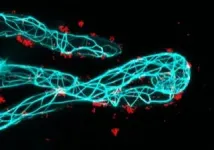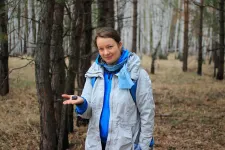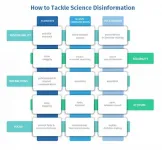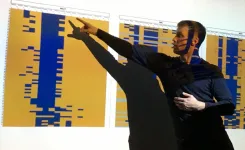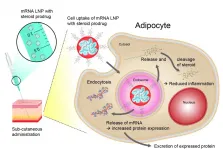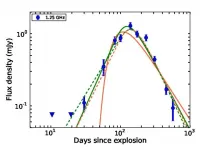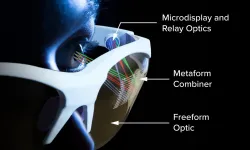(Press-News.org) A team of researchers led by Nanyang Technological University, Singapore (NTU Singapore) has developed a device that offers a quicker and less invasive way to seal tears and holes in blood vessels, using an electrically-activated glue patch applied via a minimally invasive balloon catheter.
This device could eventually replace the need for open or keyhole surgery to patch up or stitch together internal blood vessel defects.
After inserting the catheter into an appropriate blood vessel, the glue patch - nicknamed 'Voltaglue' - can be guided through the body to where the tear is located and then activated using retractable electrodes to glue it shut in a few minutes, all without making a single surgical cut.
Patented by NTU and Massachusetts Institute of Technology (MIT) scientists, Voltaglue is a new type of adhesive that works in wet environments and hardens when a voltage is applied to it.
The catheter device that deploys Voltaglue is jointly developed by Associate Professor Terry Steele from the NTU School of Materials Science and Engineering, former NTU PhD student Dr Manisha Singh, now at MIT, and Associate Professor Ellen Roche from the Department of Mechanical Engineering and Institute for Medical Engineering and Science at MIT, USA.
This catheter device is the first proof-of-concept application of Voltaglue in a medical setting since it was invented by Assoc Prof Steele in 2015.
Their research was published in the peer-reviewed scientific journal Science Advances in April.
Assoc Prof Steele said: "The system that we developed is potentially the answer to the currently unmet medical need for a minimally-invasive technique to repair arteriovenous fistulas (an abnormal connection between an artery and a vein) or vascular leaks, without the need for open surgery. With Voltaglue and the catheter device, we open up the possibility of not having to make surgical incisions to patch something up inside - we can send a catheter-based device through to do the job."
A new way to mend broken blood vessels
The catheter system is made up of two components:
i) The adhesive patch containing Voltaglue called ePATCH, which is applied to the catheter's balloon,
ii) a modified catheter with retractable wires that carry electrical current, named CATRE.
The team showed in lab experiments on a pig's heart that the Voltaglue patch can be safely and effectively administered in a variety of situations, including withstanding the high pulsatile pressure of blood in arteries like the aorta.
The device was used to close a 3 mm defect in an explanted pig aorta connected to a mock heart under continuous flow of blood of 10 ml per minute.
The flexible catheter is first inserted and guided through the blood vessel. Once at the site of the break, the balloon is expanded so that the injury is covered by the Voltaglue patch.
A small electrical charge is sent through the two wires to activate the patch. The glue's hardness can be adjusted by changing the amount of voltage applied to it, a process called electrocuring. This allows the patch to adapt to various types of tissue surfaces, from relatively smooth aortic tissue to more irregular, uneven surfaces of synthetic vascular grafts.
The patch starts to set after 20 seconds and fully hardens between 3 to 5 minutes. Upon hardening, the patch effectively 'glues' the broken vessel together, thereby sealing the two broken ends shut. The wires, deflated balloon, and catheter are then withdrawn.
In this experiment, the team left the patch on the pig heart for 1,000 physiological stress/strain cycles (heartbeats), which, at 70 beats per minute, was around 15 minutes. When the aorta was examined after the experiment, the patch was found to be still successfully sealing the gap.
The paper's first author Dr Manisha Singh, formerly from NTU School of Materials Science and Engineering, said: "Voltaglue is unlike other adhesives in the market as it is voltage-activated, is stable in wet environments and can stick onto soft tissue, making it suitable and effective for repairing blood vessels. By combining it with existing, commercially available catheters, we have developed a new delivery mechanism that is minimally invasive, yet flexible and adaptable. This system shows promise for a diverse range of medical applications, as the suitability of the patch could be tailored according to the needs of the patient."
A safe way to patch up tears in a variety of organs and vessels
The catheter is designed for use in vessels ranging from 7.5 to 30 mm in size, making it suitable for sealing defects in organs and vessels such as the aorta, intestine, and oesophagus.
Both Voltaglue and the patch are made with bioresorbable material, which are entirely degradable and dissolve after a few weeks.
These properties make the catheter suitable for potential applications such as vascular grafting, a common surgical procedure to redirect blood flow from one area to another, or to seal off blood flow to tumours, in order to kill them off.
Giving an independent comment on this innovation, Associate Professor Andrew Chin, senior consultant in the Department of Hand and Reconstructive Microsurgery at Singapore General Hospital, said: "The clinical application of this device in delivery of bio-adhesive has tremendous potential not just for vascular anastomoses (vessel connection), but other soft tissue fixation which significantly cuts down on the time taken to complete at this current point in time where suture materials are being used."
Drawing on their findings, the researchers foresee that the catheter device may someday be used to deliver patches to repair birth defects such as holes in the wall of the heart.
The research team has filed a joint patent for this device, shared between MIT and NTUitive, NTU's innovation and enterprise company.
The commercial potential of the catheter system highlights NTU's commitment to innovation in its recently announced 2025 strategic plan, which aims to translate research into products and outcomes that enhance the quality of life.
INFORMATION:
Notes to Editor:
Paper titled "Minimally Invasive Electroceutical Catheter for Endoluminal Defect Sealing", published in Science Advances, 2 April 2021. DOI: 10.1126/sciadv.abf6855
Symptoms of health anxiety are common already during childhood and adolescence - and if the children do not receive the correct help, the anxiety can become a permanent problem with serious personal and socio-economic consequences. This is shown by a new research result from Aarhus University and the University of Copenhagen.
Ida is 11 years old. Six months ago, her grandmother died of cancer after a long illness and since then Ida has become more and more anxious that she too will get cancer and die. The anxiety can be triggered when she passes by a hospital or sees people who look ill. ...
What would it be like to produce fertilizer in your own basement? Leguminous plants, like peas, beans, and various species of clover, obtain the organic nitrogen they need for their growth from symbiotic soil bacteria via specialized structures in their roots. A team led by the cell biologist Prof. Dr. Thomas Ott from the University of Freiburg's Faculty of Biology has now detected a factor in the root cells that the plants need for the initial contact with these so-called root-associated bacteria, which live in the soil. They discovered a protein found only in legumes called symbiotic formin 1 (SYFO1) and demonstrated the essential role it plays in symbiosis. Together with the molecular biologist Prof. Dr. Robert Grosse University of Freiburg's Faculty of Medicine and the evolutionary ...
In a number of biological processes, iron-sulfur clusters play a vital role, where they act as cofactors to enzymes. Research published in Angewandte Chemie now shows that cubic clusters can support unusual bonding states. This study shows that the cluster copes well with a multiple bond between iron and nitrogen--a structural motif that may be involved in biological nitrogen fixation.
Clusters made of iron and sulfur atoms are essential cofactors for a number of enzymes, especially in biological processes involving electron transfer. As an example, nitrogen-fixing bacteria use iron-sulfur clusters to convert ...
An international team of scientists from 20 countries identified 47 problems that hinder the successful prevention and elimination of the consequences of the tsunami. Based on the carried out analysis, the world's leading experts on natural hazards have outlined directions for further scientific research. The research group's review is published in a special issue of the "Frontiers in Earth Science".
The main problems identified in the review are related to the large gaps and uncertainties in knowledge about tsunami, the lack of well-documented observations, and imperfect methods of processing available information. One of the reasons is the lack of coordination of the efforts of those countries for which the study and prediction of tsunamis, forecasting the corresponding risks, and preparation ...
Berlin, 3 May - In a new report, ALLEA, the European Federation of Academies of Sciences and Humanities, examines the potential of technical and policy measures to tackle science disinformation and calls for improved European exchange and coordination in this field.
While disinformation strategies are intoxicating public discourses in many fields, science disinformation is particularly dangerous to democratic governance and society at large. As highlighted by the ongoing pandemic, an undermining of trust in science poses a fundamental threat to political and individual decisions based on evidence and scientific knowledge.
Over ...
Impaired bone health is among the most significant long-term consequences of hematopoietic stem cell transplantation (HSCT), a common therapy for patients with malignant and non-malignant haematological diseases.
To address this serious problem, the International Osteoporosis Foundation (IOF) expert Working Group on Cancer and Bone Disease has published a new Executive Summary of its authoritative state-of-the-art review. The review outlined the major factors affecting bone health in HSCT patients, and provided expert guidance for the monitoring, evaluation and treatment of bone loss in these patients. ...
Globally, tuberculosis is the most common bacterial infectious disease leading to death. The pathogen causing tuberculosis, Mycobacterium tuberculosis, has a number of peculiarities. One is that it is growing very slowly. While other typical pathogens, such as pneumococcal and pseudomonads, can already be identified by their growth in the microbiological laboratory in the first 72 hours, several weeks usually pass before tuberculosis bacteria grow in the lab. Thus it often takes one to two months before the efficacy of individual medicines can be tested.
However, these efficacy tests are essential for the effective treatment of multidrug-resistant tuberculosis (MDR-TB), which is becoming increasingly common. In these cases, the pathogen has become ...
If not before, then certainly since the first messenger RNA (mRNA) vaccines to combat the SARS CoV2 virus were approved in Germany, mRNA has become a recognized term even outside scientific circles. What is less well known is that mRNA can be used to produce much more than just vaccines. Around 50 different procedures for the treatment of diseases including cancer are already being studied in clinical trials. Scientists from the pharmaceutical company AstraZeneca, with the support of neutron researchers from Forschungszentrum Jülich, have now discovered how the subcutaneous administration of mRNA can be improved. The goal is for chronically ill ...
Scientists from the National Centre for radio Astrophysics of the Tata Institute of Fundamental Research (NCRA-TIFR) Pune used the upgraded Giant Metrewave Radio Telescope (uGMRT) to determine that AT 2018 cow, the first of a newly discovered class of cosmic explosions, has an extremely patchy environment. Sources like AT 2018cow release an enormous amount of energy, nonetheless fade extremely rapidly. This along with their extremely blue color has led to them being called FBOTs for Fast Blue Optical Transient. This is the first observational evidence of inhomogeneous emission from an FBOT. The origins of FBOTs are still under debate, but proposed models include explosion of a massive star, collision of an accreting neutron star and ...
"Image" is everything in the $20 billion market for AR/VR glasses. Consumers are looking for glasses that are compact and easy to wear, delivering high-quality imagery with socially acceptable optics that don't look like "bug eyes."
University of Rochester researchers at the Institute of Optics have come up with a novel technology to deliver those attributes with maximum effect. In a paper in Science Advances, they describe imprinting freeform optics with a nanophotonic optical element called "a metasurface."
The metasurface is a veritable forest of tiny, silver, nanoscale structures on a thin metallic film that conforms, in this advance, to the freeform shape of ...
